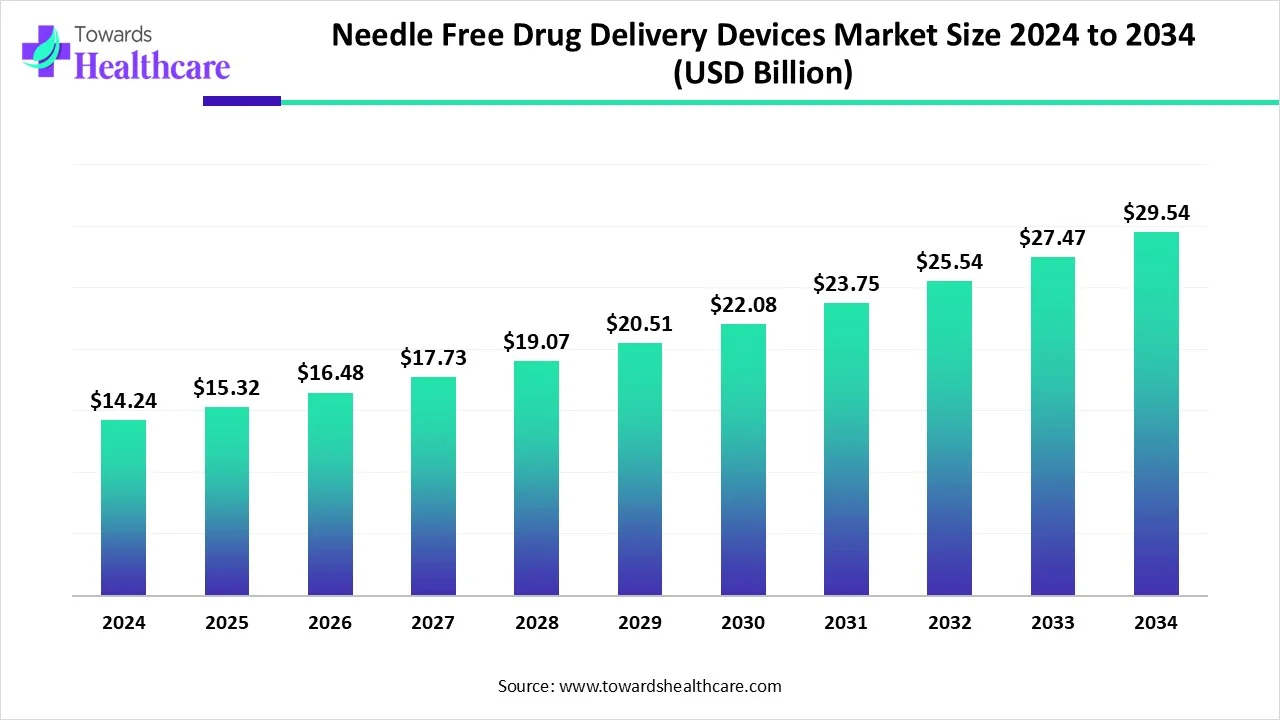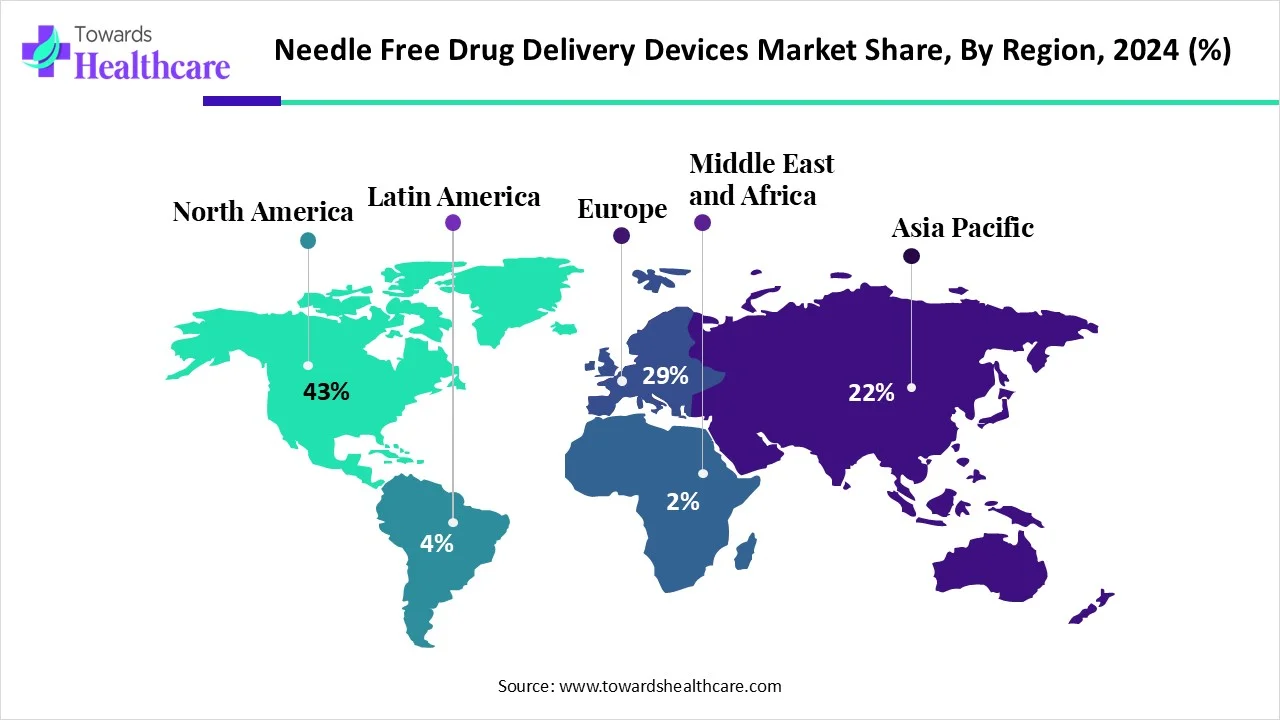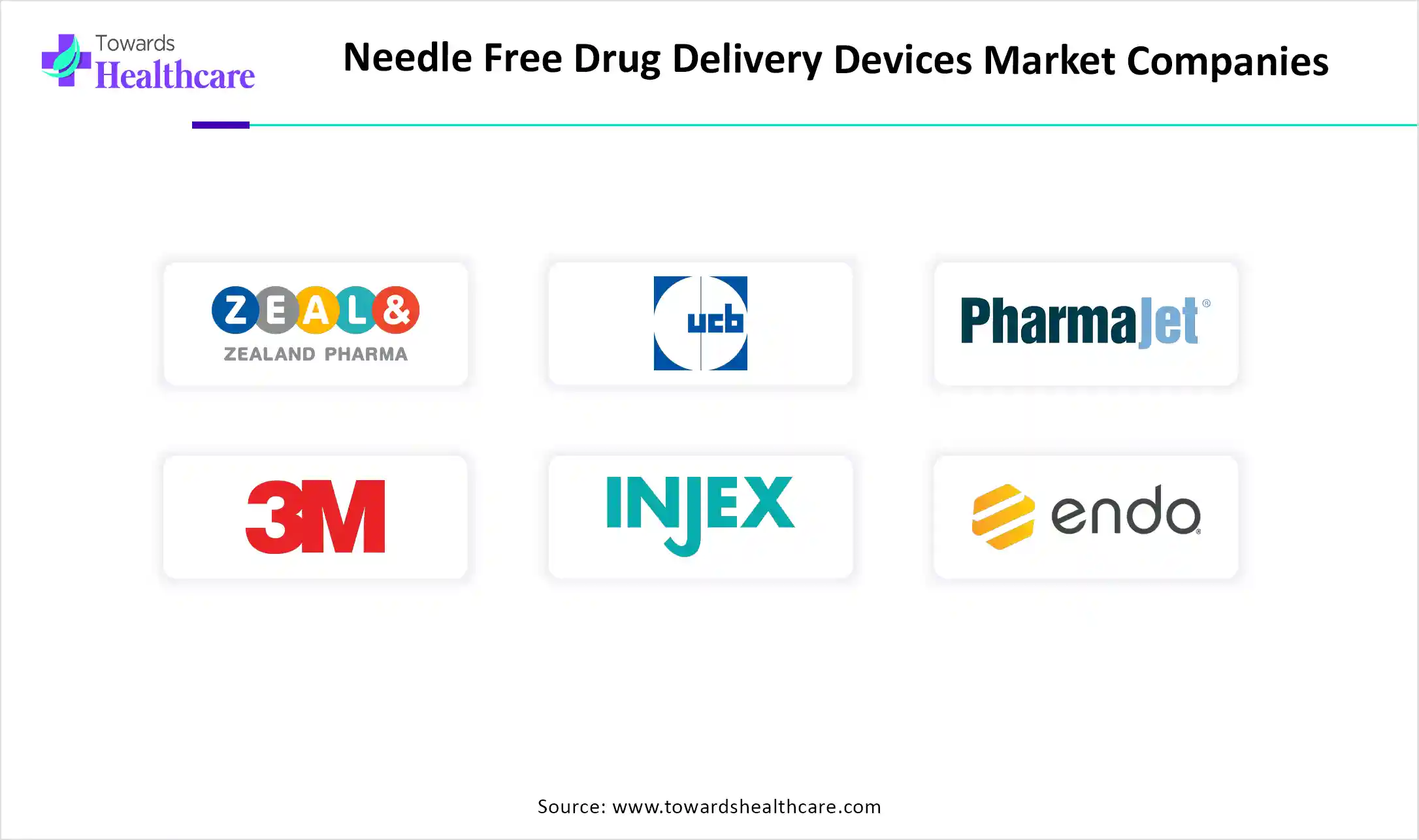December 2025

The global needle free drug delivery devices market size is calculated at USD 14.24 in 2024, grew to USD 15.32 billion in 2025, and is projected to reach around USD 29.54 billion by 2034. The market is expanding at a CAGR of 7.54% between 2025 and 2034.
In response, safer substitutes such as safety syringes, retractable needle syringes, needle-free systems, jet injectors, pen injectors, and microneedle patches have been developed as a result of technical advancements in drug administration. When compared to traditional needles, these sophisticated devices' enhanced usability, functionality, and design allow for safer medication delivery. Patient preferences have clearly shifted in favor of painless medication delivery as a result, which has increased acceptability and deployment of these devices, due to the growing popularity of drug delivery methods that do not require needles.

| Metric | Details |
| Market Size in 2025 | USD 15.32 Billion |
| Projected Market Size in 2034 | USD 29.54 Billion |
| CAGR (2025 - 2034) | 7.54% |
| Leading Region | North America share by 43% |
| Market Segmentation | By Technology, By Application, By Region |
| Top Key Players | PenJet, Zealand Pharma, UCB S.A., PharmaJet, 3M, Verdict Media Limited, INJEX Pharma AG, Antares Pharma, Endo Pharmaceuticals Inc., Bioject Medical Technologies, Inc., Crossject SA |
The concept of needle-free injection technology (NFIT) is incredibly broad and encompasses a variety of drug delivery systems that use forces such as Lorentz, shock waves, gas pressure, or electrophoresis to drive drugs through the skin, thereby eliminating the need for hypodermic needles. This method is believed to be advantageous not just for the pharmaceutical sector but also for mass vaccination programs in impoverished nations, as it eliminates the risk of needle stick injuries and other problems, such as those that arise from using a single needle repeatedly.
By improving product accuracy and efficiency, automation and artificial intelligence (AI) have had a big impact on the market for needle-free devices. The accuracy of medication delivery systems is increased by AI-driven algorithms, allowing for real-time monitoring and individualized treatment regimens. Automation guarantees constant quality in needle-free devices, lowers production costs, and streamlines manufacturing processes. In addition to increasing patient compliance, these technology developments stimulate market expansion by bringing fresh ideas and enhancing the general healthcare experience.
Smart Devices Integration
One significant and quickly rising trend in the global needle-free drug administration market is the increasing integration of smart devices and digital health platforms. This technological convergence is significantly improving patient comfort, adherence, and overall control over drug delivery. Incorporating intelligent features into needle-free medication delivery devices allows for features like intelligent alerts based on administration history and the ability to learn user adherence tendencies to modify prescription regimens.
Lack of Awareness
It is anticipated that development prospects would be hampered by poor and middle-income nations' limited awareness of needle-free injection devices. This is ascribed to the low safety standards in these areas as well as the inadequate laws and regulations governing the treatment of medical waste.
Is Home Care an Opportunity for the Needle Free Drug Delivery Devices Market?
Because of the increasing use of cloud and mobility-driven medical equipment, a shift to home care settings increases the likelihood of improved, consistent, and timely engagement between the patient and the physician. The number of patients getting home treatment has historically been small in poor nations. The integration of smart patches and jet injectors with electronic health records (EHR) enables physicians to remotely monitor doses. Drug delivery systems that do not require needles allow patients to conveniently self-administer their medications in accordance with doctors' prescriptions. Therefore, it is anticipated that a greater emphasis on at-home healthcare and the adoption of technologically integrated goods would present a development opportunity for the market throughout the projection period.
By technology, the jet injectors segment led the needle free drug delivery devices market in 2024. Needlestick-free jet injectors (NFJIs) are effective alternatives to conventional syringes for the transdermal administration of liquid medications. NFJIs provide advantages over conventional syringes, such as reduced production of hazardous waste, improved operator safety, and improved patient acceptability. All of these factors contribute to the growing popularity of NFJIs and their application in therapeutic settings.
By technology, the transdermal patch segment is expected to be the fastest-growing in the needle free drug delivery devices market during the predicted timeframe. Transdermal patches are one non-invasive technique to deliver medicine. In order to treat a range of ailments, transdermal patches have attracted attention and been used for decades to deliver drugs including fentanyl, nicotine, nitroglycerin, and clonidine. Recently, this method has been studied for a variety of biologic delivery applications.
By application, the insulin delivery segment held the largest share of the needle free drug delivery devices market in 2024. Insulin administration without a needle seemed like a great idea, and its appeal stemmed from the fact that it was secure and pleasant. The creation of needle-free medication administration systems is now interested on the delivery of insulin via alternate routes. In their efforts to create alternate insulin delivery technology, major international pharmaceutical corporations are making positive strides.
By application, the pediatric injections segment is estimated to grow at the fastest rate in the needle free drug delivery devices market during the upcoming years. In terms of patient acceptability and compliance, injections are frequently less favored than oral routes due to needle anxiety and the pain experienced during the procedure, especially in kids. Pharmaceutical research has long been focused on needleless injection systems that use the transdermal interface to deliver drugs.

North America dominated the needle free drug delivery devices market share by 43% in 2024. Dominance by area can be attributed to a number of factors, including the presence of innovative pharmaceutical businesses, the region's robust healthcare infrastructure, and the growing use of cutting-edge medical technology. While needle-free injectors are being used more often for diabetes control and insulin infusion, the United States and Canada are leading the way in vaccine initiatives. PharmaJet and Injex Pharma, two of the major participants in this market, are eager to diversify their holdings in order to meet the rising demand.
Between 2015 and 2030, there will be a 54% increase in the number of Americans with diabetes (type 2 and type 1 diabetes), a 38% increase in the number of deaths from diabetes, and a 53% increase in the total annual medical and societal costs associated with diabetes, reaching over $622 billion. By preventing or delaying the onset of type 2 diabetes, aggressive community health initiatives, such as expanding access to diabetes preventive programs, might help reverse these alarming predictions for millions of individuals. In this regard, the introduction of needle-free solutions can be quite beneficial.
In addition to working with partners on this award program, Diabetes Canada is pleased to be one of Canada's top sponsors of diabetes research. The End Diabetes Awards fund studies aimed at improving our knowledge of diabetes and how to prevent, treat, manage, and cure it. All four pillars of health research are welcome to submit funding applications to Diabetes Canada, which guarantees that the greatest biological, clinical, health services, and/or public health research is supported in the pursuit of a world free from the consequences of diabetes. Diabetes Canada and its partners want to use the 2025 End Diabetes Awards to provide $6 million. Up to $150,000 annually for a maximum of three years is what applicants may request, for a total of $450,000 per award.
Asia Pacific is estimated to host the fastest-growing needle free drug delivery devices market during the forecast period, fueled by nations like China, Japan, and India's growing urbanization, rising disposable incomes, and technology breakthroughs. Adoption of needle-free medication delivery is being driven by the region's increasing preference for easily accessible home healthcare options, which are bolstered by government programs encouraging digitalization in healthcare. Additionally, the cost and accessibility of needle-free medication delivery systems and components are reaching a larger patient population as APAC develops into a manufacturing hub.
In China, the number of people with diabetes is rising quickly. At almost 25% of the world's diabetes population, China now has one of the highest rates of diabetes in the world. A global health concern, diabetes is expected to impact 1·31 billion people by 2050, having afflicted 529 million people in 2021. Food preferences and eating habits have changed as a result of the growing online meal delivery market via smartphone apps. In China, there will be more than half a billion online meal delivery customers by 2023.
Over the past 25 years, the number of people with diabetes has increased rapidly, and India has played a major role in this worldwide trend. Diabetes has become a significant issue in India due to its rapid rise in both rural and urban areas. The market for diabetes care products is expected to be worth billions of dollars by 2025, when over 100 million Indians are expected to have been diagnosed with the disease.
Europe is expected to grow significantly in the needle free drug delivery devices market during the forecast period. Europe maintains a significant scale by rewarding clinically verifiable benefits through value-based reimbursement. Thanks to its homegrown pharmaceutical companies and a payer system that is open to outcome-linked pricing, Germany leads the area in revenue. In line with EU Green Deal goals, sustainability imperatives drive research and development into bio-derived polymers and recyclable housing. Glass prefilled syringes are being replaced by autoinjectors as safety-engineered features reduce the risk of unintentional sticks. The relevance of ergonomic testing during approvals is increased by the European Medicines Agency's emphasis on patient-reported outcomes, which promotes comprehensive device design throughout the market for needle-free drug delivery systems.
The aging population's dramatic rise in both type 1 and type 2 diabetes presents significant issues for the German healthcare system in the years to come. In Germany, the number of persons with T2D will rise from 6.8 million in 2015 to between 10.9 million and 14.2 million in 2040, depending on how long these observed increases in incidence persist. According to these figures, the prevalence increased from 10.5% in 2015 to 15.5% to 20.1% in 2040. Under 2040, there were 8.1 million persons with T2D and an overall prevalence of 11.4% under the constant prevalence scenario.
According to "alarming" studies, one in five people in the UK now have diabetes or pre-diabetes, a result of increased obesity rates, more unhealthy diets, and a "broken" food environment. 12.2 million people are affected, according to data analysis from Diabetes UK. Of these, 4.6 million have been diagnosed with diabetes, 1.3 million have an undiagnosed version of the illness, and 6.3 million have non-diabetic hyperglycemia, sometimes known as pre-diabetes. It is the highest amount ever recorded.

In December 2024, we are thrilled to be expanding NuGen's global distribution to a new level in order to control diabetes and provide needle-free insulin administration. With InsuJet authorized for use in 42 countries, Canada, the birthplace of insulin, is a wonderful location for us to follow, according to Karen Dunlap, interim CEO of NuGen. To support this robust expansion, we are integrating our technical IP expertise with the marketing and clinical initiatives of our distributor. (Source - Drug Delivery Business)
By Technology
By Application
By Region
December 2025
December 2025
December 2025
November 2025